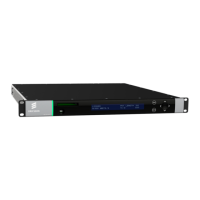Using the Equipment
• Frequency domain for the channel’s centre frequency – Frequencies usually
allocated for digital terrestrial broadcasting are defined in Table 3.8.
Table 3.8 Frequencies Allocated for Digital Terrestrial Broadcasting
Band Working Range (MHz)
VHF III (174 + B/2) and (230 – B/2)
UHF IV/V (470 + B/2) and (862 – B/2)
Where B = the selected signal bandwidth.
3.10.7.7 Web Browser Setup
Main Page
Figure 3.57 Basic Configuration GUI
• System – This configures the band plan for the particular country, these can be
B/G or D/K. Configuring this determines which items appear in “Channel”.
- B/G´ system – In this system Channel is split as follows:
xvii. VHF III is split into eight channels named B-channels, each with 7 MHz
bandwidth.
xviii. UHF IV and V is split into 8 MHz channels.
- D/K system – In this system Channel is split as follows:
xix. VHF III is split into seven channels named D-channels, their bandwidth
is 8 MHz.
xx. UHF IV and V is split into 8 MHz channels.
• Frequency – There are three menu items used to set the frequency to be tuned.
These three objects are:
- Channel – This is pre defined “TV Channel” for a pre-defined region as
defined in Table 3.9.
- Frequency – This is the center frequency, in MHz, to be tuned to (see
Table 3.9).
- Channels Found – This defines all of the channels found when the tuner
last scanned across its frequency range (see Table 3.9).
Each of the above controls can be used to tune the unit, i.e. a channel defines a
pre-defined frequency; for example within the B/G band plan, the following
channels map to the following frequencies.

